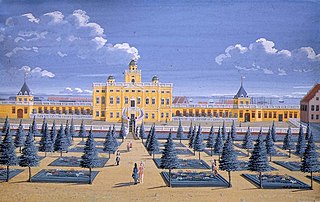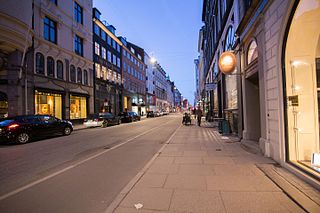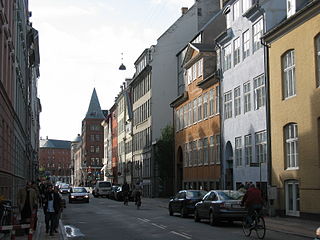
Amalienborg is the official residence for the Danish royal family, and is located in Copenhagen, Denmark. Frederick VIII's Palace is the residence of King Frederik X and Queen Mary. It consists of four identical classical palace façades with rococo interiors around an octagonal courtyard ; in the centre of the square is a monumental equestrian statue of Amalienborg's founder, King Frederick V.

Arnold Mærsk Mc-Kinney Møller was a Danish shipping magnate. He was a longtime figure at A.P. Moller–Maersk Group, which was founded by his father.

Kastellet is a citadel located in Copenhagen, Denmark. It is one of the best preserved fortresses in Northern Europe. It is constructed in the form of a pentagon with bastions at its corners. Kastellet was continuous with the ring of bastioned ramparts which used to encircle Copenhagen but of which only the ramparts of Christianshavn remain today.

The Copenhagen Opera House is the national opera house of Denmark, and among the most modern opera houses in the world. It is also one of the most expensive opera houses ever built at a cost of 2.5 billion DKK. It is located on the island of Holmen in central Copenhagen.

Frederiksstaden is a district in Copenhagen, Denmark. Constructed during the reign of Frederick V in the second half of the 18th century, it is considered to be one of the most important rococo complexes in Europe and was included in the 2006 Danish Culture Canon.

Amaliegade is a street in central Copenhagen, Denmark, which makes up the longer of the two axes on which the Rococo district Frederiksstaden is centred. Amaliegade extends from Sankt Annæ Plads to Esplanaden, passing through the central plaza of Amalienborg Palace on the way where it intersects Frederiksgade, the other, shorter but more prominent, axis of the district.

The Royal Library Garden, often referred to simply as the Library Garden, is a small, somewhat hidden garden between the Royal Library, the Tøjhus Museum, ChristianIV's Supply Depot and Christiansborg Palace on Slotsholmen in central Copenhagen, Denmark. It has a reputation for being one of the most tranquil spots in the city centre.

The Yellow Palace, or Bergum's Mansion, is an 18th-century town mansion situated at Amaliegade 18, next to Amalienborg Palace, in the Frederiksstaden district of Copenhagen, Denmark. It is considered the first example of Neoclassical architecture in Copenhagen.

Sankt Annæ Plads is a public square which marks the border between the Nyhavn area and Frederiksstaden neighborhoods of central Copenhagen, Denmark. It is a long narrow rectangle which extends inland from the waterfront, at a point just north of the Royal Danish Playhouse at the base of the Kvæsthus Pier, now known as Ofelia Plads, until it meets Bredgade. A major renovation of the square was completed in 2016.The Garrison Church is located on the south side of the square. Amaliegade, one of the two axes on which Frederiksstaden is centered, extends from the square.

Frederiksgade is a street in the Frederiksstaden neighbourhood of central Copenhagen. It runs east from Store Kongensgade to Toldbodgade on the waterfront, passing the Marble Church, Bredgade and Amaliegade on the way. At the Marble Church the street splits and curves around both sides of the church before rejoining on its other side.

Sophie Amalienborg was a pleasure palace roughly located where Amalienborg stands today in Copenhagen, Denmark. It was built by Queen Consort Sophie Amalie who lived there until her death in 1685 after her husband, King Frederick III, died a few years prior to its completion.

Thingvalla line was a shipping company founded by Danish financier, industrialist and philanthropist Carl Frederik Tietgen in 1879 in Copenhagen, Denmark. It maintained a route between Copenhagen and New York City calling at Kristiania and Kristiansand on the way. At its peak, it had ten ships in its fleet. In 1898, the company was bought by DFDS, another Danish shipping company, and the name was changed to Scandinavian America Line.

Bredgade is one of the most prominent streets in Copenhagen, Denmark. Running in a straight line from Kongens Nytorv for just under one kilometre to the intersection of Esplanaden and Grønningen, it is one of the major streets in Frederiksstaden, a Rococo district laid out in the middle of the 18th century to commemorate the tercentenary of the House of Oldenburg's accession to the Danish throne. It is lined with a number of fine mansions as well as other historic buildings. Many law firms, trade unions, fashion stores and art galleries are based in the street. The street also runs parallel to the Royal residence Amalienborg and Frederik's Church

Esplanaden is a street in Copenhagen, Denmark. It extends eastwards from Store Kongensgade and runs along the south side of the city's 17th-century fortress Kastellet and Churchillparken until it reaches the waterfront at Nordre Toldbod, just south of Langelinie, passing Amaliegade, Bredgade and Grønningen on the way. It marks the northern border of the Frederiksstaden district.

Larsens Plads is a waterfront in Copenhagen, Denmark, which runs along the Zealand side of the main harbour from the Nyhavn canal in the south to the Nordre Toldbod area just south of Langelinie to the north. The name refers to a shipyard which used to occupy the grounds but is now more associated with emigration to America after it became a major hub for trans-Atlantic traffic later in the century. It is dominated by Amalienborg Palace with the Amalie Garden and a number of late 18th-century warehouses which have been converted to other uses. The buildings facing the waterfront have their address on the parallel street Toldbodgade.

Dronningegården is a Modernist residential complex in central Copenhagen, Denmark, consisting of four L-shaped buildings defining an urban space around the intersection of Adelgade and Dronningens Tværgade. Designed by Kay Fisker in collaboration with C. F. Møller and Svenn Eske Kristensen, it was built between 1943 and 1958, during the transition from Traditionalism to Modernism, as a notable example of Nordic Functionalism.

Toldbodgade is a street in central Copenhagen, Denmark. It extends north from Nyhavn at the Nyhavn Bridge, continuing Holberggade, passes Sankt Annæ Plads after just one block, and continues straight until it reaches West India Warehouse where it makes a sharp left turn which connects it to Amaliegade, its parallel street, at the rear of the Design Museum.

Asiatisk Plads is a waterfront area in the Christianshavn neighbourhood of Copenhagen, Denmark. It is bounded by Torvegade to the south, next to Knippel Bridge, Strandgade to the east and the Old Dock area to the north. It takes its name from Danish Asia Company which was based at the site from its foundation in 1732 until 1843 when it was dissolved. The Ministry of Foreign Affairs is now based in the area, in a purpose-built office complex from 1980 as well as in the surviving buildings of the Danish Asia Company, its former head office and two converted warehouses, all of which are listed. Asiatisk Plads is frequently used as a metonym for the Ministry.

The Dehn Mansion is one of two identical but mirror-imag Rococo-style town mansions on Bredgade, flanking the entrance to Amalienborg via Frederiksgade, in the Frederiksstaden district of Copenhagen, Denmark. It takes its name after Friedrich Ludwig von Dehn, its first owner. The mansion was later divided into two separate properties. The larger, northn part of the mansion is now owned by the Danish Association of Pharmaconomists. The southern part is owned by Karberghus. The building was listed in the Danish registry of protected buildings and places in 1918.

The Bernstorff Mansion is a Rococo-style town mansion situated at the corner of Bredgade and Frederiksgade in the Frederiksstaden district of central Copenhagen, Denmark. It complements the Dehn Mansion on the other corner, contributing to the symmetry of Frederiksstaden's Frederiksgade axis. The town mansion remained in the hands of the Bernstorff family until 1799. It has also been referred to as Prince Ferdinand's Mansion and King George's Mansion after two later owners. The Supreme Court was based on the beletage from the fire of the second Christiansborg Palace in 1884 until the completion of its current building in 1919. Four large gobelins by François Boucher were sold in around 1900 and are now in the collection of the Metropolitan Museum. The building was listed on the Danish registry of protected buildings and places in 1918. It is now owned by Jeudan.




























